Practice the AP 10th Class Biology Bits with Answers Chapter 8 Heredity on a regular basis so that you can attempt exams with utmost confidence.
AP State Syllabus 10th Class Biology Bits 8th Lesson Heredity with Answers
Concept – 1 : Introduction – New Characters and Variations
Question 1.
Which of the following is not a variation in rose plant ?
A) Coloured petals
B) Spines
C) Tendrils
D) Leaf margin
Answer:
C) Tendrils
Question 2.
Observe the following a and b statements.
a : All the family members have identical characters,
b : Differences in character within very closely related groups of organisms are referred to as variations.
A) a and b both are true
B) a is true, b is false
C) a is false, b is true
D) a and b both are false
Answer:
C) a is false, b is true
![]()
Question 3.
The process of transmission of varied characters to offspring from parents
A) Inheritance
B) Mutations
C) Diversity
D) Environment
Answer:
A) Inheritance
Question 4.
The exchange of genetic material takes place in:
A) vegetative reproduction
B) asexual reproduction
C) sexual reproduction
D) budding
Answer:
C) sexual reproduction
Question 5.
Passing of characters from parents to offsprings is called
A) Heredity
B) Natural selection
C) Variations
D) Acquired characters
Answer:
A) Heredity
Concept – 2 : Mendelian Characters
Question 6.
Father of Genetics
A) Darwin
B) Morgan
C) Wallace
D) Mendel
Answer:
D) Mendel
Question 7.
According to Mendel, alleles have the following character
A) Pair of genes
B) Responsible for character
C) Production of gametes
D) Recessive factors
Answer:
A) Pair of genes
Question 8.
Gregor Mendel, a scientist belongs to ……………… country. He used ……………….. as a laboratory.
A) Germany, Science lab
B) Austria, Monastery garden
C) Austria, Royal science lab
D) Germany, Monastery garden
Answer:
B) Austria, Monastery garden
Question 9.
Which of the following is a unique identification to each individual ?
A) Iris of eye
B) Marking on thumb
C) Ear lobes
D) Only A & B
Answer:
D) Only A & B
![]()
Question 10.
Which of the following statements is NOT true about the Mendel’s selection of garden pea for his experiment ?
A) Well defined characters
B) Bisexual flowers
C) Predominantly self fertilisation
D) Cheap is cost
Answer:
D) Cheap is cost
Question 11.
According to Mendel, each character is expressed due to a pair of alleles or traits, which are known as
A) Genes in pairs
B) Response for the character
C) Production of gametes
D) Inherent character
Answer:
A) Genes in pairs
Concept – 3 : Examples of Experiments Performed by Mendel
Question 12.
The genotypic ratio in F1 generation when crossed the tall and short plants.
A) 1 : 2: 1
B) 3 : 1
C) 9 : 3 : 3 :1
D) 1 : 2 : 3
Answer:
A)1 : 2: 1
Question 13.
From which of the following F2 generation is produced ?
A) Parental generation
B) F2 generation
C) F1 generation
D) From F2 generation only
Answer:
C) F1 generation
Question 14.
The % of short character in F2 generation is ………………..
A) 100%
B) 75%
C) 50%
D) 25%
Answer:
D) 25%
Question 15.
If the % of long plants is 75, then it should be represented in ………………….
A) Genotype
B) Phenotype
C) General
D) Can’t say
Answer:
B) Phenotype
Question 16.
According to Mendel, for one character there is a pair of
A) Traits
B) Factors
C) Genes
D) Homozygous
Answer:
B) Factors
![]()
Question 17.
The long plants always produce long plants only
A) Yes
B) No
C) Can’t say
D) Short plants also produced
Answer:
D) Short plants also produced
Question 18.
The plants where the dominant character is maintained for successive generations is …………………
A) Pure breed
B) Cross breed
C) Heterozygous
D) Dominants
Answer:
A) Pure breed
Question 19.
Which of the following is not the reason for choosing of pea plant by Mendel for his experiments ?
A) Having bisexual flower
B) Annual plant
C) Self – Pollination
D) Not suitable for crossing
Answer:
D) Not suitable for crossing
Question 20.
Observe the a, b statements.
a : Yellow colour YY is pure breed.
b : Green colour yy is also pure breed.
A) Both a and b are true
B) a is true, b is false
C) a is false b is true
D) Both a and b are false
Answer:
A) Both a and b are true
Question 21.
In F1 generation, if Y is dominated over y, thfcn y is called …………….. character.
A) Recessive
B) Dominant
C) Phenotype
D) Genotype
Answer:
A) Recessive
Question 22.
The alleles or factors which were named by Mendel are known as …………….
A) Genes
B) Heritable factors
C) Factors
D) Traits
Answer:
A) Genes
Question 23.
Why did Mendel select pea plants for his experiments ?
A) Consists of unisexual flowers
B) Consists of bisexual flowers
C) Conducting self fertilisation
D) B and C
Answer:
D) B and C
![]()
Question 24.
In F1 generation the character which is expressed is ……………… and not expressed one is ……………………
A) Recessive, Dominant
B) Dominant, Recessive
C) Pure breed, Dominant
D) Dominant, Pure breed
Answer:
B) Dominant, Recessive
Question 25.
The visible characteristic in an organism is known as:
A) prototype
B) stereotype
C) phenotype
D) genotype
Answer:
C) phenotype
Question 26.
1 : 2 : 1 of F2 generation is ……………….
A) Phenotypic ratio
B) Genotypic ratio
C) Homozygous
D) Heterozygous
Answer:
B) Genotypic ratio
Question 27.
We indicate yellow or green as ……………. and round or wrinkled as ………………
A) YYRR
B) YyYy
C) Yy-Rr
D) yy-rr
Answer:
C) Yy-Rr
Question 28.
Which of the following is not related to the character which was observed by Mendel ?
A) Colour of the flower
B) Colour of the seed
C) Colour of unripen pod
D) Colour of root
Answer:
D) Colour of root
Question 29.
Which of the following may be used to obtain F2 generation ?
A) allowirig flowers in a parent plant to be self-pollinated
B) allowing flowers in F1 plant to be self- pollinated
C) cross-pollinating F1 plant with a parent plant
D) cross-pollinating two parent plants
Answer:
B) allowing flowers in F1 plant to be self- pollinated
Question 30.
If Yy represents yellow colour, then which colour will be dominant ?
A) Green
B) White
C) Yellow
D) Red
Answer:
C) Yellow
![]()
Question 31.
Read the following information
A pea plant having two copies of the gene for tallness (TT) pollinates with a pea plant having two copies of the gene for dwarf ness (tt). The resulting offspring produced after pollination, was found to be tall.
What genetic combination is predicted in the offspring?
A) only tt
B) Only Tt
QTt or TT
D)tt or TT
Answer:
B) Only Tt
Question 32.
From the results, it can be concluded that in F2 generation the actual number of round seeds Mendel obtained were:
A) 1881
B) 22572
C) 2508
D) 5643
Answer:
D) 5643
Question 33.
If there are two identical factors for a character, it is called ………………..
A) Heterozygous
B) Homozygous
C) Allele
D) Genetic form
Answer:
B) Homozygous
Question 34.
If there are two different factors for a character, it is called …………………..
A) Heterozygous
B) Homozygous
C) Independent assorts
D) Dominant
Answer:
A) Heterozygous
Question 35.
The pair of genes for each character is represented as
A) Heterozygous
B) Homozygous
C) Alleles
D) Factors
Answer:
C) Alleles
Question 36.
Passing of traits independently is known as ………………….
A) Law of Dominance
B) Law of Segregation
C) Formula of Gene factor
D) Law of Independent Assortment
Answer:
D) Law of Independent Assortment
Question 37.
The law which states that “Among two factors, one is passed to or expressed in the progeny” is called ………………
A) Law of Dominance
B) Law of Segregation
C) Formula of Gene factor
D) Law of Independent assortment
Answer:
A) Law of Dominance
![]()
Question 38.
The receiving of one allele each from both parents is called ………………….
A) Law of Dominance
B) Law of Segregation
C) Formula of Gene factor
D) Law of Independent assortment
Answer:
B) Law of Segregation
Question 39.
The characters that transmit from parent to offspring are …………………..
A) Genetic characters
B) Heritable characters
C) Heridital characters
D) Intellect, cleverness
Answer:
B) Heritable characters
Question 40.
The transmission of character or traits from parents to offsprings is called
A) Heredity
B) Inheritance
C) Heir
D) Respect of family
Answer:
A) Heredity
Question 41.
In order to ensure that he had pure-breeding plants for his experiments, Mendel:
A) cross-fertilised each variety with each other
B) let each variety self fertilise for several – generations
C) removed the female parts of the plants
D) removed the male parts of the plants.
Answer:
B) let each variety self fertilise for several – generations
Question 42.
A cross between a tall plant (TT) and short plant (tt) resulted in progeny that were all tall plants because :
A) tallness is the dominant trait
B) shortness is the dominant trait
C) tallness is the recessive trait
D) height of plant is not governed by gene T or t
Answer:
A) tallness is the dominant trait
Question 43.
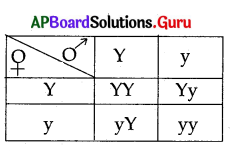
The above box indicates
A) Gross pollination in F1 – generation
B) Self pollination in F1 – generation
C) Cross pollination in F2 – generation
D) Self pollination in F2 – generation
Answer:
B) Self pollination in F1 – generation
Question 44.
Which of the following statements is not true?
A) Malthus theory was written in ‘An essay on the principles of population’.
B) The ‘Origin of Species’ was written by Charles Lyell.
C) The theory of ‘Natural Selection’ was proposed by Charles Darwin.
D) Jean Baptist Lamark proposed a theory of ‘Inheritance of acquired characters’.
Answer:
B) The ‘Origin of Species’ was written by Charles Lyell.
![]()
Question 45.
What is genotypic ratio of monohybrid crdss between homozygous tall pea plant with homozygous dwarf pea plant?
A) 2 : 1 : 1
B) 1 : 1 : 2
C) 1 : 2 :1
D) 2 : 2 : 1
Answer:
C) 1 : 2 :1
Question 46.
Study the following:
a) Phenotype ratio 3 : 1
b) Genotype ratio 9 : 3 : 3 : 1
Identify the correct ones.
A) a, b
B) a is correct and b is not correct
C) a is incorrect and b is correct
D) Both a, b incorrect
Answer:
B) a is correct and b is not correct
Question 47.
Yellow and round seeded pea plant has ‘ genotype YyRr. The gametes produced shall be ………………….
A) Yy, Rr
B) YR, yR, Yr, yr
C) YR, yr
D) Y, y, R, r
Answer:
D) Y, y, R, r
Question 48.
When a pure yellow seed plant is crossed with a pure green seed plant in F1 generation, the seeds are ……………….
A) all yellow seeds
B) all green seeds
C) 75% yellow, 25% green seeds
D) 50% yellow, 50% green seeds
Answer:
C) 75% yellow, 25% green seeds
Question 49.
Pheotypic ratio of Fj generation in Mendel’s monohybrid cross
A) 1 : 2 : 1
B) 2 : 1
C) 3 : 1
D) 1 : 5 : 2
Answer:
C) 3 : 1
Question 50.
In pea plants, a pure tall plant (TT) is crossed with a pure short plant (tt). The ratio of pure tall plants to pure short plant in F1 generation will be …………………
A) 1 : 3
B) 3 : 1
C) 1 : 1
D) 2 : 1
Answer:
B) 3 : 1
Concept – 3 : Parent to Progeny
Question 51.
The sexual chromosome will be represented as ……………. in males and as ………. in females.
A) XX, XY
B) YY, XX
C) XXX, XY
D) XY, XX
Answer:
D) XY, XX
![]()
Question 52.
Girl: XX Chromosomes :: Boy:………………
A) XY Chromosomes
B) LX Chromosomes
C) XL Chromosomes
D) XX Chromosomes
Answer:
A) XY Chromosomes
Question 53.
In human beings DNA controls the characters whereas in viruses ………….. controls the character.
A) RNA
B) ABA
C) Synthetic DNA
D) Retro RNA
Answer:
A) RNA
Question 54.
The structure of ,DNA is …………………..
A) Spherical
B) Double helix
C) Straight
D) Circular
Answer:
B) Double helix
Question 55.
Which of the following is not the base of Nitrogen in DNA ?
A) Adenine
B) Guanine
C) Uracil
D) Thymine
Answer:
C) Uracil
Question 56.
The number of autosomes in human beings
A) 23 pairs
B) 22 pairs
C) 1 pair
D) 46 pairs
Answer:
B) 22 pairs
Question 57.
The allosome in males is ………………..
A) XX
B) XXX
C) XY
D) XO
Answer:
C) XY
Question 58.
Raju’s chromosomes are 44 + XY and his wife Rani’s chromosomes are 44 + XX. Then their first male child will have these chromosomes
A) 44 + XX
B) 22 + XX
C) 44 + XY
D) 44 + YY
Answer:
C) 44 + XY
![]()
Question 59.
The bodily changes …………………..
A) bring changes in DNA
B) help in evolution
C) do not bring changes in DNA
D) bring changes in RNA
Answer:
C) do not bring changes in DNA
Question 60.
Scientist who discovered the structure of DNA is
A) Watson
B) Crick
C) Both
D) None of them
Answer:
C) Both
Question 61.
Gene : DNA:: Virus : ……………….. ?
A) DNA
B) NAA
C) RNA
D) IAA
Answer:
C) RNA
Question 62.
Who, in the following is not related to the discovery of DNA ?
A) James Watson
B) Francis Crick
C) Mouris Wilkinse
D) James Douglas
Answer:
D) James Douglas
Question 63.
The following picture depicts the DNA. What is the structure of DNA ?
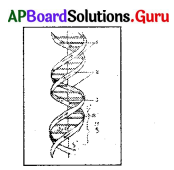
A) Spherical
B) Double Helix
C) Dumbell
D) Round and longitudinal
Answer:
B) Double Helix
Question 64.
During the following, variation occurs.
i) During reproduction
ii) Changes in DNA transcription
iii) Changes in RNA transcription
iv) Synthesis of protein
A) i, ii, iii only
B) i only
C) i and ii only
D) i and iv only
Answer:
C) i and ii only
Question 65.
In human males all the chromosomes are paired perfectly except one. This/ these unpaired chromosomes is/are :
i) large chromosome
ii) small chromosome
iii) Y chromosome
iv) X chromosome
A) i and ii
B) iii only
C) iii and iv
D) ii and iv
Answer:
C) iii and iv
![]()
Question 66.
Wfliich of the following statements is incorrect with respect to variations ?
A) All variations in a species have equal chance of survival
B) Change in genetic compositionresults in variations
C) Selection of variations by environmental factors is the basis of evolutionary process
D) Variations are minimum in asexual reproduction
Answer:
A) All variations in a species have equal chance of survival
Question 67.
New species may be formed if :
i) DNA undergoes significant changes in germ cells .
ii) Chromosome number changes in the gamete
iii) There is no change in the genetic material
iv) Mating does not take place
A) i and ii
B) i and ii
C) i, iii and iv
D) i, ii and iii
Answer:
B) i and ii
Question 68.
Observe the pictorial representation of sex determination in human beings. The A and B in the below given picture respectively represents :
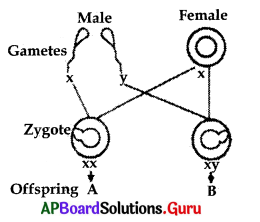
A) Male, Female
B) Female, Male
C) Male, Male
D) Female, Female
Answer:
B) Female, Male
Question 69.
Select the statements that describe characteristics of genes :
i) Genes are specific sequence of bases in a DNA molecule
ii) A gene does not code for proteins
iii) In individuals of a given species, gene is located on a particular chromosome
iv) Each chromosome has only one gene.
A) i and ii
B) i and iii
C) i and iv
D) ii and iv
Answer:
B) i and iii
Concept – 5 : Evolution
Question 70.
Weak deer cannot live long in a forest according to Darwin’s principle.
What concept does it show ?
A) Evolution
B) Acquired character
C) Ecosystem
D) Survival of the fittest
Answer:
D) Survival of the fittest
Question 71.
In Galapagos Islands, Darwin observed variations in structure in …………………….
A) Elephants
B) Giraffes
C) Rats
D) Finch birds
Answer:
D) Finch birds
Question 72.
Finch birds are found in ……………. island.
A) Java, Sumitra
B) Andaman, Nicobar
C) Galapagos
D) Hawai
Answer:
C) Galapagos
![]()
Question 73.
Natural selection means
A) Nature selects desirable characters
B) Nature rejects undesirable characters
C) Nature reacts with an organism
D) A and B
Answer:
D) A and B
Question 74.
The scientist who defined the Heredity basing on the Giraffe ………………
A) Charles Darwin
B) Lamarck
C) William Harvey
D) Beagle
Answer:
B) Lamarck
Question 75.
The scientist who proved that the bodily changes are not inherited is …………………..
A) Charles Darwin
B) Weissmann
C) Lamarck
D) Harvey
Answer:
B) Weissmann
Question 76.
The organisms which have the patagium (skin folds) is …………………
A) Bat
B) Owl
C) Fish
D) Aves
Answer:
A) Bat
Question 77.
Evolution is a :
A) Slow process
B) Discontinuous process
C) Continuous process
D) Both A and C
Answer:
A) Slow process
Question 78.
Slow and stable process is ………………….
A) Evolution
B) Quantity
C) Mutation
D) Variation
Answer:
A) Evolution
Question 79.
The change occurring suddenly or spontaneously is …………………….
A) Evolution
B) Variation
C) Mutation
D) Genetic change
Answer:
C) Mutation
![]()
Question 80.
The fly on which Morgan experimented …………………
A) Musca Domestica
B) Apis Meliphera
C) Oenotheora
D) Drosophila Melanogastor
Answer:
D) Drosophila Melanogastor
Question 81.
The small changes in the frequency of genes in small population is called
A) Genetic change
B) Alleles
C) Natural selection
D) Genetic drift
Answer:
D) Genetic drift
Question 82.
The scientist who proposed the Evolution Theory
A) Charles Darwin
B) August Weismann
C) Alfred Wallace
D) Jean Lamarck
Answer:
D) Jean Lamarck
Question 83.
According to theory of Lamarck ………………………
A) inheritable traits are not useful for heredity
B) acquiring the traits is so difficult
C) the acquired traits passed onto its progeny
D) the bodily changes inherit
Answer:
C) the acquired traits passed onto its progeny
Question 84.
Which is not the contrasting character Mendel chose in pea plant ?
A) Shape and colour of pod
B) Colour and position of flower
C) Shape and colour of seed
D) Length and thickness of stem
Answer:
D) Length and thickness of stem
Question 85.
The “Origin of Species” is written by …………………….
A) Charles Darwin
B) Baptiste Lamarck
C) Charles Lyell
D) Gregor Johann Mendel
Answer:
A) Charles Darwin
Question 86.
Find the correct statement(s) regarding Darwin :
A) He was born in England.
B) He proposed natural selection theory
C) He observed birds diversity in the Galopagos Islands.
D) All the above
Answer:
D) All the above
Question 87.
Travelling by the ship HMS Beagle Charles Darwin landed on one of these islands.
A) Maldives
B) Andaman, Nicobar islands
C) Galapagos islands
D) Fiji islands
Answer:
C) Galapagos islands
![]()
Question 88.
The book “Principles of Geology” was written by
A) Charles Darwin
B) Charles Lyell
C) Malthus
D) J.B. Lamarck
Answer:
B) Charles Lyell
Question 89.
Theory of natural selection is influenced by the theory of;
A) Darwin
B) Malthus
C) Lyell
D) Lamarck
Answer:
B) Malthus
Concept – 6 : Acquired and Inherited Characters and Evolution
Question 90.
The scientist who studied on rats by cutting their tails and disproved Lamarck theory is ………………..
A) Darwin
B) Watson
C) Weismann
D) Mendel
Answer:
C) Weismann
Question 91.
The propounder of Natural Selection is …………………
A) August Weismann
B) Charles Darwin
C) Malthus
D) Charles Lyell
Answer:
B) Charles Darwin
Question 92.
The scientist who proposed the Theory of Population is ………………………
A) Malthus
B) Charles Darwin
C) Charles Lyell
D) Weismann
Answer:
A) Malthus
Question 93.
The scientist who suggested the geological changes occurred in a uniform rate …………………….
A) Malthus
B) Charles Darwin
C) Charles Lyell
D) Weismann
Answer:
C) Charles Lyell
Question 94
……………. influences whether the organism should survive or perish in nature.
A) Growth of organism
B) Genes
C) Nature
D) Variations
Answer:
C) Nature
![]()
Question 95.
The scientist who also proposed like Darwin that the new organisms formed due to the natural selection.
A) T. S. Huxley
B) A. R. Wallace
C) Charles Lyell
D) August Weismann
Answer:
B) A. R. Wallace
Question 96.
Match the following.
| 1. DNA | a) Father of Genetics |
| 2. Mendel | b) Natural selection |
| 3. Darwin | c) Double helix |
A) 1 – a, 2 – b, 3 – c
B) 1 – b, 2 – c, 3 – a
C) 1 – c, 2 – b, 3 – a
D) 1 – c, 2 – a, 3 – b
Answer:
D) 1 – c, 2 – a, 3 – b
Concept – 7 : Speciation and Evidences of Evolution
Question 97.
The small changes within the species are called ……………….
A) Macro evolution
B) Variation
C) Mutation
D) Micro evolution
Answer:
D) Micro evolution
Question 98.
The changes in large species leading to formation of new species is called
A) Macro evolution
B) Variation
C) Mutation
D) Micro evolution
Answer:
A) Macro evolution
Question 99.
The fore limb (fins) of a whale, wings of a bat, legs of a cheetah are the examples of ………………….
A) Homologous organs
B) Divergent evolution
C) Analogous organs
D) Convergent evolution
Answer:
A) Homologous organs
Question 100.
Which of the following are Analogous organs ?
A) Wings of birds, leg of a cheetah
B) Wings of bat, fins of whale
C) Wings of birds, wings of bat
D) Wings of bat, legs of horse
Answer:
C) Wings of birds, wings of bat
Question 101.
In which of the following patagium is found?
A) Birds
B) Wings of Bat
C) Tail of Monkey
D) Fin of Whale
Answer:
B) Wings of Bat
![]()
Question 102
……………… is the study of the development of an organism from egg to adult stage.
A) Biogeology
B) Science of Evolution
C) Embryology
D) Cell science
Answer:
C) Embryology
Question 103.
The larva of frog resembles to ……………….
A) Frog
B) Aves
C) Fish
D) Reptile
Answer:
C) Fish
Question 104.
The science which revealed that there is a common ancestor from which all the vertebrates are evolved
A) Palaeontology
B) Embryology
C) Morphology
D) Science of Evolution
Answer:
B) Embryology
Question 105.
Organs having same anatomical structure but differ in their function are called homologous organs. Organs having different anatomical structure but perform same functions are called analogous organs. Then what are the homologous organs among the following ?
1. Leg of a cheetah
2. Wing of a bat
3. Wing of a bird
A) 2 and 3
B) 1 and 3
C) 1 and 2
D) All the above
Answer:
C) 1 and 2
Question 106.
Find the odd one out as per homologous organs.
A) Blue whale(whale)
B) Pigeon
C) Bat
D) Man
Answer:
B) Pigeon
Question 107.
What phenomenon is depicted in the below given picture ?

A) Natural selection
B) Variation
C) Speciation
D) Segregation
Answer:
C) Speciation
Question 108.
Macro evolution is:
A) The process of species formation
B) The process of genus formation
C) The process of formation of family
D) The process of order formation
Answer:
A) The process of species formation
![]()
Question 109.
The following diagrams are examples of ………………

A) Analogous organs
B) Homologous organs
C) Catalogous organs
D) Anabolic organs
Answer:
B) Homologous organs
Question 110.
Which of the following statements is incorrect ?
A) Forelimbs of a whale, wings of a bat, legs of a cheetah, hands of a man are the examples of homologous organs.
B) The study of fossils is called paleontology.
C) Embryology is the study of the development of an organism from egg to adult.
D) There are nearly 150 vestigial organs in human beings.
Answer:
C) Embryology is the study of the development of an organism from egg to adult.
Question 111.
The wings of bats have skin folds
stretched between elongated fingers is called……………….
A) Adipose
B) Patagium
C) Blupper
D) Malphigium
Answer:
B) Patagium
Concept – 8 : Fossils
Question 112.
The method of determining the age of fossils.
A) Potassium dating
B) Radium dating
C) Carbon dating
D) Uranium dating
Answer:
C) Carbon dating
Question 113.
The age of fossils is determined by calculating the half life period of
A) Isobars
B) Isotopes
C) Radio activitiy
D) Carbon dating
Answer:
D) Carbon dating
Question 114.
The connecting link between aves and reptiles is ………………….
A) Dinosaurs
B) Lizard
C) Omithorinchus
D) Archeopteryx
Answer:
D) Archeopteryx
Question 115.
Some unused organs remain in the body are called
A) Homologous organs
B) Vestigial organs
C) Analogous organs
D) Convergent organs
Answer:
B) Vestigial organs
![]()
Question 116.
The fossil found in Adilabad of Telangana state is ……………….
A) Ecthyosaurs
B) Boronchiosaurs
C) Ketosaurs
D) Condricthes
Answer:
C) Ketosaurs
Question 117.
Amphibians, reptiles, birds and mammals indicate a common ancestry as they have
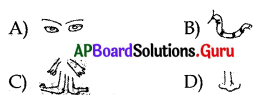
Answer:
![]()
Question 118.
In which of the following rocks the fossils were formed ?
A) Magnus rocks
B) Sediments
C) Modified rocks
D) All of the above
Answer:
B) Sediments
Question 119.
Reason for dying of red colour beetles and increase of green coloured beetles …………………….
A) Green beetles have more resistance
B) Less life time in red coloured beetles
C) Variation in the colour
D) Crows like red coloured beetles
Answer:
C) Variation in the colour
Question 120.
Palaeontologist deals with
A) Embryological evidences
B) Fossil evidences
C) Vestigial organ evidences
D) All
Answer:
B) Fossil evidences
Question 121.
Appendix ………………..
A) Essential in the human digestive system
B) Not useful for digestive system
C) The main part of small intestine
D) The part of large intestine
Answer:
B) Not useful for digestive system
Question 122.
The moving museum of vestigial organs is …………………..
A) Homoerectus
B) Existing man
C) Chimpanzee
D) Neanderthal man
Answer:
B) Existing man
Question 123.
The study of fossils is ………………….
A) Geology
B) Embryology
C) Palaeontology
D) Science of Evolution
Answer:
C) Palaeontology
![]()
Question 124.
Which of the following diagrams represent the fossils ?
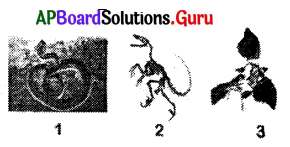
A) 1
B) 2 and 3
C) 1 and 2
D) All the above
Answer:
D) All the above
Question 125.
Which of the following statement(s) is (are) true about human evolution ?
A) All humans are a single species the Homo sapiens.
B) Skin colour is the most common way of identifying the races.
C) The genetic foot prints of humans, (Homo sapiens), show that all human beings have evolved
D) All the above
Answer:
D) All the above
Question 126.
The organs which perform different functions but have the same basic structure are known as
A) homologous organs
B) analogous organs
C) homoloytic organs
D) analytic organs
Answer:
A) homologous organs
Question 127.
The appearance of vestigial organs in human beings is called :
A) Darwinism
B) Lamarckism
C) Atavism
D) Both A and B
Answer:
C) Atavism
Question 128.
Homosapiens appeared about these years ago.
A) 1.8 million
B) 40,000
C) 3,00,000
D) 2.5 million
Answer:
B) 40,000
Question 129.
Number of vestigial organs present in human beings is ………………………
A) 95
B) 120
C) 180
D) 240
Answer:
C) 180